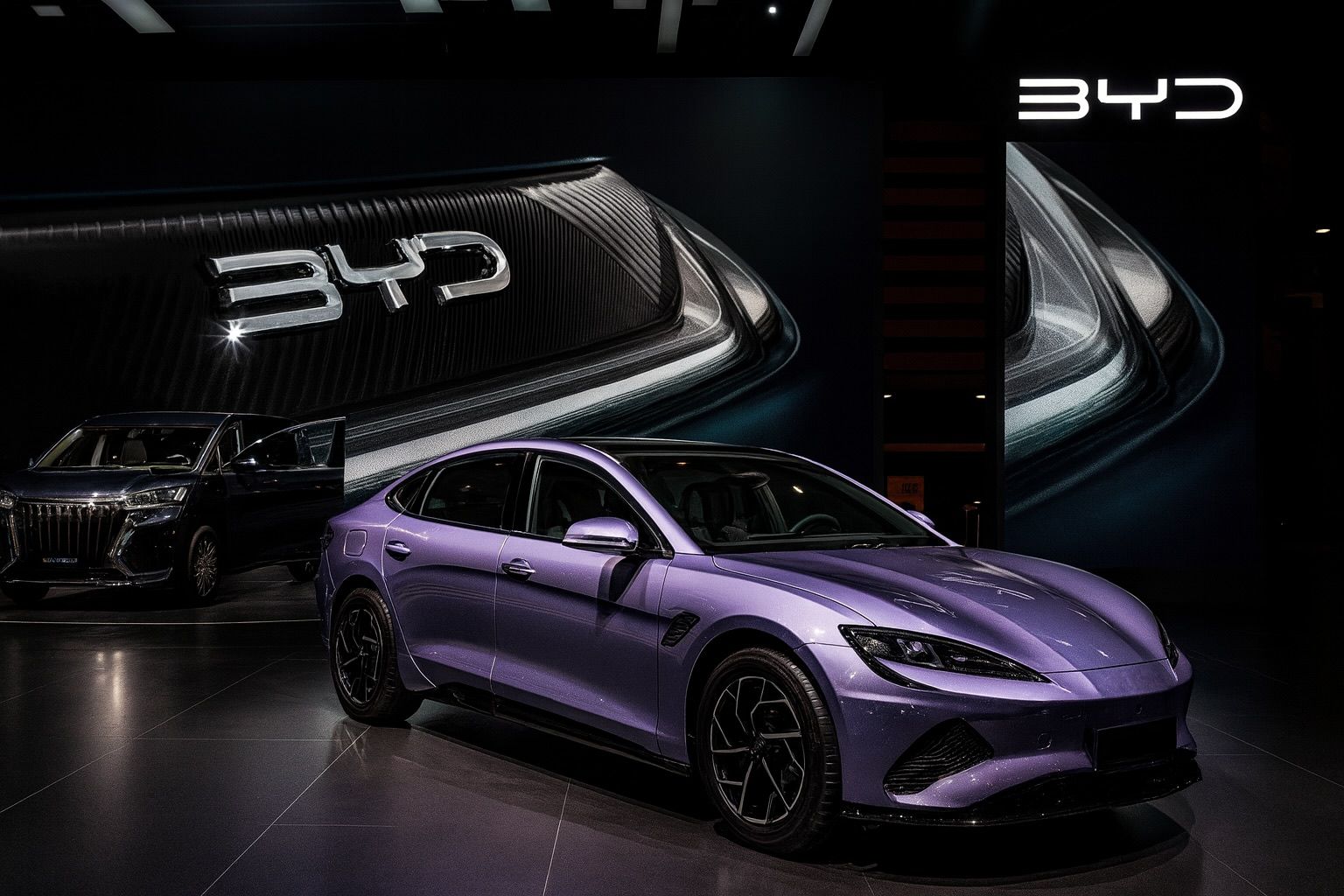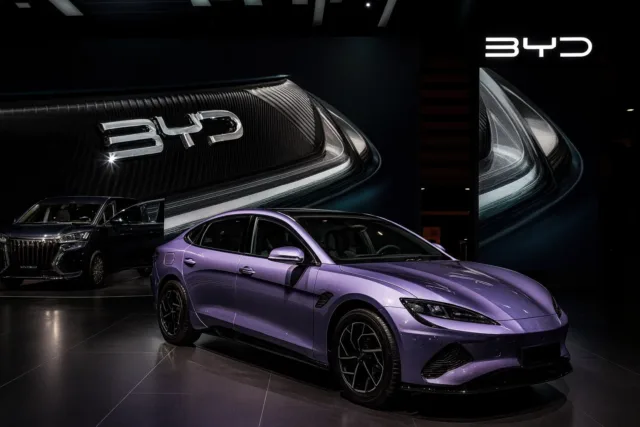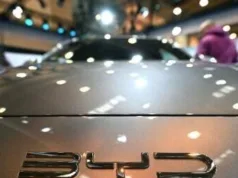
- BYD profit crash: Chinese EV leader BYD reported Q3 sales of ¥195 billion (≈€23.6 billion) and profit of ¥7.8 billion – a year-on-year revenue drop of ~3% and a profit plunge of almost one-third [1]. Analysts attribute the slump to an intense price war in China [2] [3]. BYD’s net income had already fallen ~30% in Q2, its first decline in over three years [4].
- Surging overseas sales: Paradoxically, BYD’s global push is accelerating. In September 2025, BYD logged 24,963 new-car registrations in Europe – nearly 5× last year’s level – while Tesla’s European sales fell 10.5% year-on-year [5]. An independent analyst notes this shows BYD’s “internationalisation strategy is working well” [6]. BYD is opening 2,000 European showrooms by 2026 and plans to locally produce all its sold models by 2028 [7].
- Chinese brands flood Europe: Chinese automakers (BYD, Chery/Jetour/Omoda/Jaecoo, Changan, Geely/Lynk, Nio, etc.) are aggressively expanding in Europe [8] [9]. BYD is building new EV plants in Hungary and Turkey to serve the Continent [10], and Chery’s sub-brands recently launched in multiple EU markets [11]. Chinese car share in EU sales has nearly doubled: Chinese brands held ~4.8% of European new-car registrations in Jan–Jul 2025, up from ~2.5% a year earlier [12]. This growth persists despite EU import tariffs on Chinese EVs [13] [14].
- German industry under pressure: German automakers are losing ground. In China, legacy brands (VW, BMW, Mercedes) have ceded market share to domestic players like BYD, Geely and SAIC [15]. At home, Volkswagen’s CEO Herbert Diess warned in 2024 that “VW, BMW and Mercedes will perish” without change [16]. German carmakers posted mixed earnings (Mercedes’ margins exceeded forecasts [17], Toyota hit record highs) but face a bigger challenge from shifting market dynamics [18] [19].
- Public debate and concerns: Media and consumers are sharply divided. A FOCUS Online debate under the headline “What if an ‘electrobomber’ needs servicing?” captured the mood. Many German readers voiced doubts about Chinese EV quality and safety, fearing build defects, electronics malfunctions and sparse parts/service networks [20] [21]. Others praise China’s rapid innovation (comparing it to Japan/Korea’s rise) but remain cautious about long-term reliability [22]. The term “Elektrobomber” (colloquial for heavy EV) reflects anxiety that these cheap, long-range Chinese cars may deliver a ‘negative’ in resale and dependability over time [23].
BYD’s Earnings Dive amid Fierce Price War
BYD’s October 2025 report shocked investors: third-quarter profit plunged to ¥7.8 billion, down almost 33% from a year ago [24]. CEO Wang Chuanfu has slashed prices across BYD’s model range to fend off competition, triggering the rare profit drop. (In Q2 2025 BYD had already warned of a 30% net income drop [25].) Analysts say this reflects Beijing’s crackdown on extreme discounting in China’s overheated EV market [26] [27]. Despite the revenue hit, BYD remains China’s sales leader: its 1H 2025 revenue ($51.9 B) exceeded Tesla’s ($41.8 B) for the first time [28], illustrating its massive volume advantage.
However, BYD’s aggressive pricing “strategy” now worries investors. As one market analyst notes, there is “real concern around BYD’s aggressive ‘market share gain by pricing’ strategy… in the short term, this should weigh on margins” [29]. Indeed, BYD cut its 2025 sales target from 5.5 million to 4.6 million vehicles [30] [31], acknowledging that the China price war will damp growth.
Chinese Automakers Storm Europe
While BYD grapples with China’s market, it and its compatriots are attacking Europe. For example, Reuters reports BYD is investing in a new EV plant in Hungary (online by end-2025) and another in Turkey (2026), aiming to localize production of all European models by 2028 [32]. Chery Automobile – the world’s largest Chinese exporter – has launched its Omoda and Jaecoo brands in Germany and Omoda/Jetour in Poland [33] [34], planning hundreds of dealerships by 2027 [35]. Jaguar’s data firm JATO confirms Chinese brands almost doubled their EU market share to 4.8% in the first half of 2025 [36].
This expansion comes even as Brussels levies 25–40% tariffs on Chinese EV imports. “Tariffs will not stop the Chinese,” warns consultant Xing Zhou – with the U.S. largely closed off for political reasons, “Europe is all that’s left” [37]. BYD’s own numbers show explosive growth: through July 2025 BYD’s EU sales climbed 290% year-on-year to 84,000 cars [38], as it rolls out 13 models in Europe (up from 6 in 2023) and plans to double showrooms by 2026 [39]. In contrast, Tesla’s EU sales fell in late 2025 [40], partly due to an aging model lineup.
Legacy European carmakers are responding: BMW and Mercedes are unveiling new EV models (e.g. BMW iX3, Mercedes GLC EV, VW’s new ID.Polo) at IAA Munich 2025 [41]. McKinsey’s Harald Deubener notes “from a product perspective” this year’s show is “much more important” than before for German brands [42]. But analysts like Phil Dunne (Stax) warn “Western manufacturers have been a bit too complacent… the Chinese are here to stay” [43].
German Industry Grapples with Competition
All this feeds a crisis narrative in Germany. At IAA Munich 2025, trade economist Dr. Martin Braml told Euronews that domestic problems far outweigh external threats. He blamed high labor costs, onerous regulation and green mandates for hamstringing Germany: “The state must set the framework… supply-chain laws have ultimately placed obstacles in the way of businesses [44].” Braml called the EU’s 2035 combustion-engine ban a “destructive economic policy” that could wipe out jobs [45] [46]. He also noted that US tariffs and Chinese competition “are not the main problems” facing German automakers [47].
Nevertheless, German carmakers are feeling the squeeze. VW, BMW and Mercedes together used to control ~25% of China’s market; now domestic brands dominate many segments [48]. The Financial Times reported VW lost its status as China’s No.1 in mid-2025. Back home, major layoffs and plant shutdowns at Opel, VW, BMW and Mercedes since 2024 attest to the stress of transitioning to EVs. Fitch Ratings warns that Chinese electric ventures and tariffs are “stressing European automakers’ margins” in 2025.
At the same time, Ford and GM just reported surprisingly strong results in Q3 2025 [49], showing legacy automakers can adapt. Toyota hit record stock highs on hybrid sales [50]. But German giants find themselves in the crossfire of a tug-of-war over the EV future. As one analyst put it: “It’s Europe versus China,” with Chinese firms pouring models into Europe while Europeans fret over new technologies and subsidies [51].
Consumer Fears and Policy Debate
Media coverage reveals a mix of admiration and anxiety among Germans. Newspapers and forums highlight both China’s EV breakthroughs and lingering doubts. A FOCUS Online discussion titled “Was ist, wenn mal so ein Elektrobomber in die Werkstatt muss?” (“What if an ‘electrobomber’ ever needs servicing?”) underscores this ambivalence. Many German commenters “express strong doubts about the quality and safety of Chinese cars”, fearing shoddy workmanship, unreliable electronics, poor spare-parts supply and collapsing resale values [52]. Others admire China’s speed: one notes the shift is reminiscent of when Japanese cars outran Europe in the 1970s [53].
In practice, German consumers ask: will the lower sticker price of a Chinese EV outweigh risks of long-term service and support? Industry sources emphasize that companies like Chery/Omoda are promising robust dealer networks and warranties (e.g. 7 years/150k km on cars, 8 years on batteries) to assuage trust. Still, comments like “After ten years I think the car will have a big minus [in value]… money burned and never drove a quality car” reflect skepticism [54]. Quality-control experts note that although Chinese brands have dramatically improved, “Made in China” still carries a trust deficit in Europe.
Policy debates add fuel to the fire. Critics argue that both Chinese state subsidies and generous German EV incentives distort competition. The EU’s new tariffs on subsidized Chinese EVs have supporters and detractors: some say they’re needed to level the playing field, others claim they penalize consumers (since Europe continues to heavily subsidize its own carmakers). German politicians are split, with some (like Bayerns premier Söder) calling for a softer transition to EVs. In response, Chancellor Merz has pushed for “greater flexibility” on CO₂ rules. Against this backdrop, many Germans see Chinese EVs as a litmus test for the country’s high-tech future and industrial policy.
Outlook: Innovation vs. Industry Politics
Experts stress that the auto sector’s future will be decided by a mix of market forces and policies. Trade economist Braml argues Germany must improve its business climate or risk decline, regardless of China [55] [56]. Meanwhile, industry analysts note China’s EV surge may have peaked as domestic oversupply curbs growth: a recent Reuters investigation reported chronic oversupply and price cuts in China [57] [58]. Any Chinese slowdown could ease pressure on Europe.
But the reality is clear: Chinese EV makers have gone from fringe to formidable in just a few years. As Gartner’s Pedro Pacheco bluntly puts it: “It’s Europe versus China” in the electric-car market [59]. For German automakers, the challenge is urgent – they must not only innovate but also address consumer confidence and cost structures. Whether through new joint ventures, EV alliances (e.g. recent pools with BYD and Leapmotor [60]) or product launches, the incumbents are scrambling. The next few years will reveal if Europe’s industry can weather the Chinese wave or if the “Elektrobomber” era signals a profound realignment of the auto world.
Sources: Latest industry and financial reports [61] [62] [63] [64] [65] [66] [67], as well as analysis by TechStock² and Reuters.
References
1. de.investing.com, 2. de.investing.com, 3. ts2.tech, 4. ts2.tech, 5. www.scmp.com, 6. www.scmp.com, 7. www.scmp.com, 8. www.reuters.com, 9. www.reuters.com, 10. www.reuters.com, 11. www.reuters.com, 12. www.reuters.com, 13. www.reuters.com, 14. ts2.tech, 15. www.focus.de, 16. www.focus.de, 17. ts2.tech, 18. ts2.tech, 19. www.reuters.com, 20. www.focus.de, 21. www.focus.de, 22. www.focus.de, 23. www.focus.de, 24. de.investing.com, 25. ts2.tech, 26. ts2.tech, 27. ts2.tech, 28. ts2.tech, 29. ts2.tech, 30. ts2.tech, 31. ts2.tech, 32. www.reuters.com, 33. www.focus.de, 34. www.reuters.com, 35. www.focus.de, 36. www.reuters.com, 37. www.reuters.com, 38. www.reuters.com, 39. www.scmp.com, 40. www.scmp.com, 41. www.reuters.com, 42. www.reuters.com, 43. www.reuters.com, 44. www.euronews.com, 45. www.euronews.com, 46. www.euronews.com, 47. www.euronews.com, 48. www.focus.de, 49. ts2.tech, 50. ts2.tech, 51. www.reuters.com, 52. www.focus.de, 53. www.focus.de, 54. www.focus.de, 55. www.euronews.com, 56. www.euronews.com, 57. www.reuters.com, 58. www.reuters.com, 59. www.reuters.com, 60. www.reuters.com, 61. de.investing.com, 62. ts2.tech, 63. www.reuters.com, 64. www.reuters.com, 65. www.euronews.com, 66. www.scmp.com, 67. ts2.tech









